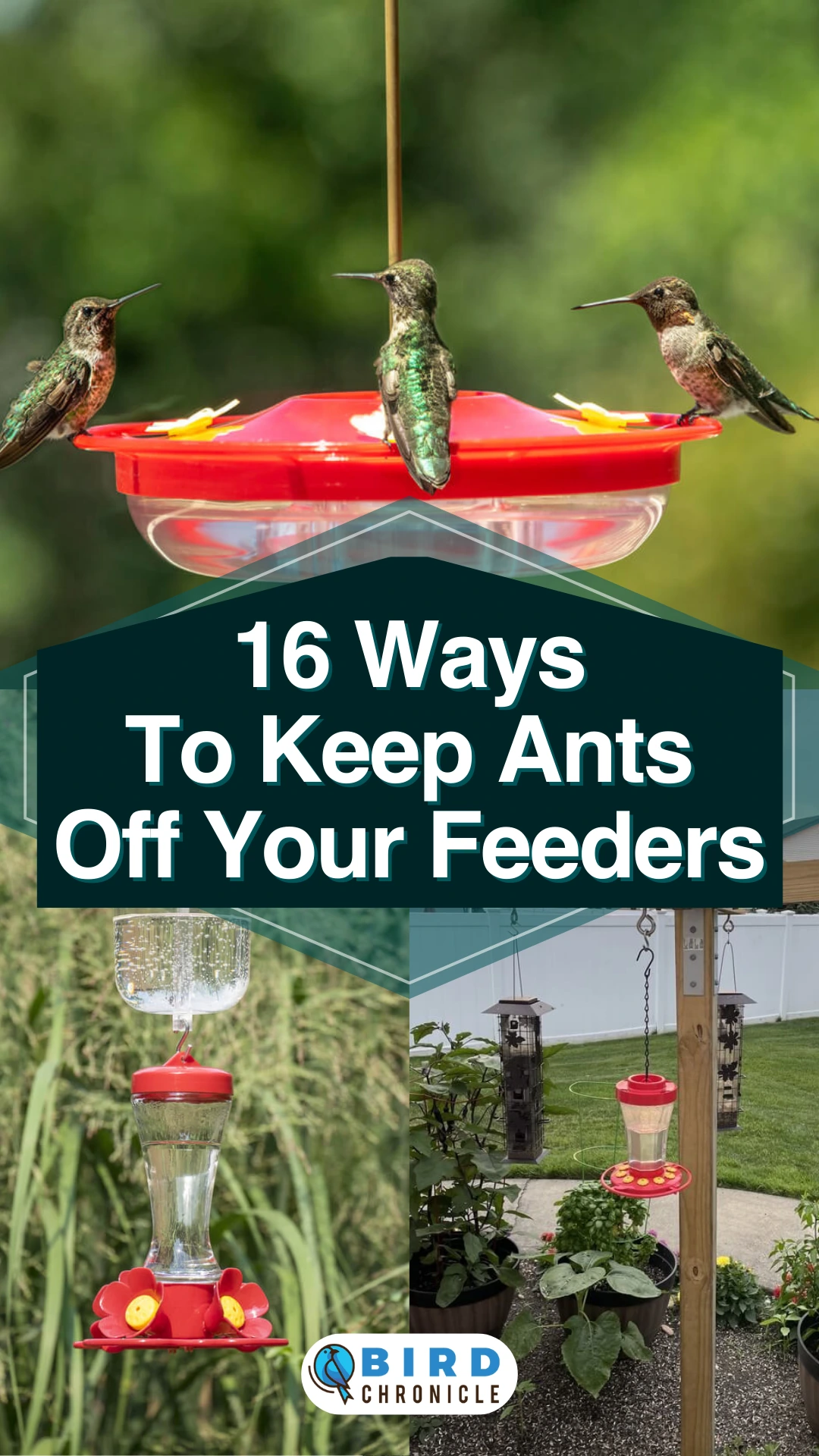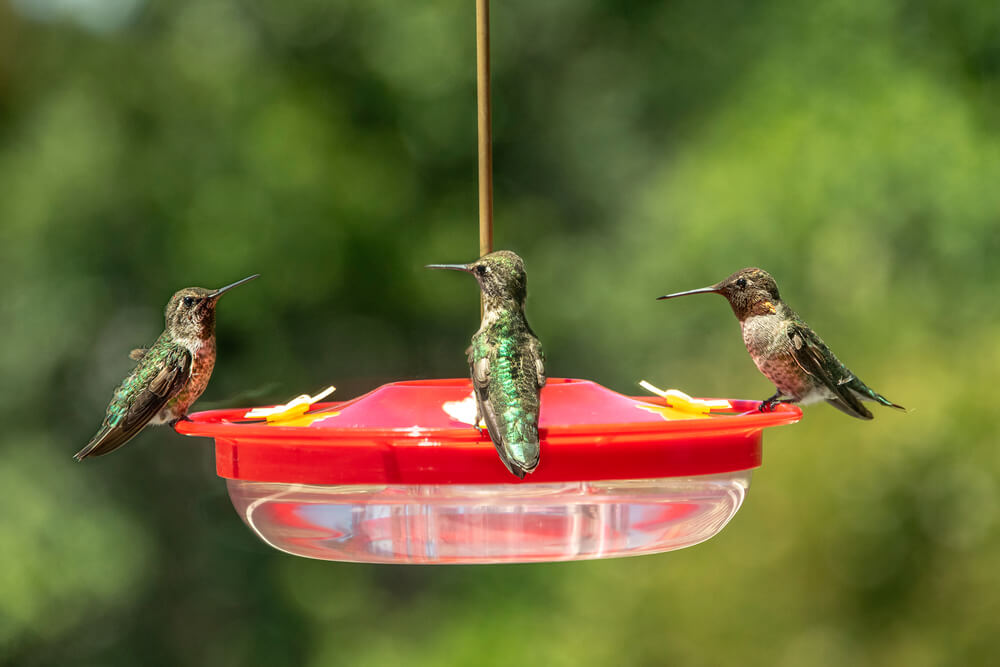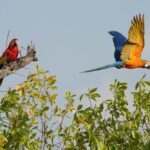Ants can become a nuisance and even cause problems for your birds. When ants invade, there are many ways in which to deter or keep them away from bird feeders.
Some of the ways to keep ants off your feeders include, but are not limited to, the following:
- Suspended or grounded water moats
- Feeder maintenance
- Feeder relocation
- Use of pungent natural plants and kitchen ingredients
- Essential oil sprays
- Commercial products
- Creating slippery or sticky surfaces

Read on to learn more in detail about these methods and more, as well as how to keep the birds safe when implementing them.
16 Ways To Keep Ants Off Your Feeders
Ants will enjoy bird foods that are sweet and sticky such as nectar, sugar water, jelly, and fruit. These are often used in feeders for hummingbirds and orioles.
However, ants will also eat from bird seed or suet, especially if there is a sweet or fruity component. Ants will also eat the sap of plants, insect eggs, insects, small invertebrates, and human food.
With a varied diet, ants therefore will seek out food sources. When they invade bird feeders, it can deter birds from visiting.
If ants become trapped in hummingbird sugar water, the liquid can become contaminated, further deterring the hummingbirds.
The following methods can keep ants (as well as wasps and bees in many cases) out of your bird feeders. Many of these are DIY or natural options.
It is important to ensure that you not only keep the ants away but that you keep birds (and other animals) safe from harm.
If one method doesn’t work, don’t give up! Consider trying more than one method, or several at once, to find what works best for you.
1. Ant Moats: 4 Kinds

Many species of ants cannot swim, yet their bodies can repel water and they may float, make a bridge, or glide.
Typically, water is not a preferred mode of transportation for ants, and they may avoid it if other sources of food are more easily accessible.
The use of an ant moat is one of the more common and easy methods to keep ants away. In other cases, you can purchase or make one.
The water in the moat may need replacement daily, especially in hot weather.
There are 4 kinds of moats that you can try: preinstalled, commercial attachment, DIY, or ground-based.
Preinstalled Moat
Some feeders, such as those for hummingbirds and orioles, may come with an ant moat preinstalled. Typically, it is installed in the center of the bird feeder or above it.
Commercial Cup Moat
This kind of cup-like moat product can be purchased for use with any bird feeder that has a hook to suspend it.
This moat has hooks on both ends of it. The bottom hook attaches to the feeder, and the top hook attaches to the branch or pole.
Some styles of moats look like mini-umbrellas but serve the same purpose as the cup style.
DIY Suspended Moat
You can make a suspended moat by upcycling some household items.
Gather the following materials:
- Plastic soda or lemon juice bottle with cap (choose a size that complements the size of your feeder)
- A wire coat hanger or other sturdy wire (choose wire that can accommodate the weight of your filled feeder)
- Hot glue gun and hot glue sticks or a waterproof caulk
- Scissors or utility knife
- Wire cutters
- Plier
- Drill and thin drill bit or finishing nail and hammer
- Safety gloves
What To Do:
- Cut the top of the soda bottle, to create a bowl-like shape for the moat.
- Typically, it should be at least an inch deep.
- Keep the cap.
- Take care not to cut yourself with tools or the edges of the cut plastic.
- Cut the coat hanger or wire with enough length to connect to your hanging post and feeder.
- Aim for about 12-inches or more.
- If your filled feeder is too heavy for wire, you can try nuts and bolts connected through the cap, with a small chain.
- Drill or hammer a small hole into the center of the cap that is slightly smaller than the diameter of the wire.
- Push the wire (or pull with pliers) through the hole.
- Then twist the cap onto the bottle top so that the wire comes up through the plastic moat.
- Bend the ends of the wire to form hooks.
- Use the pliers as needed to assist with this.
- Adjust the wire’s positioning as needed.
- Seal the point where the wire goes through the cap with hot glue or waterproof caulk.
- Allow this to dry vertically so that it is balanced.
- Consider hanging it from a pole, branch, or even the shower curtain rod so it can dry in the ideal position.
- Take note that the hot glue could melt the plastic, so use it cautiously.
- Once dry, hang your feeder from the bottom hook.
- Then, hang it up outside in your desired location from the top hook.
- Fill the moat with water.
Alternatively, you can use a laundry detergent cap to make a moat. This video demonstrates how to do that:
DIY Ground Moat
If you use a pole to hang the feeder, sink it into a formed and sunken concrete moat.
Form the curved shape with the underside of a plastic bowl (one that can be discarded after use).
Conversely, a less permanent ground moat could be done with a sturdy plastic bowl, with a hole drilled through it for the pole.
Seal the seam where the pole goes through, so that water does not leak out, with a waterproof caulk.
2. Use Unsweetened Seed Mixes
If ants are a problem for feeders that do not have liquid or jelly, opt for suet or birdseed mixes that do not have fruit pieces in them.
Ants are likely to seek out sweet food sources first.
3. Stop Leaks
For feeders that use sweet liquid, it is essential to repair any leaks or to fully replace the feeder. Ants will easily find the drips of nectar on the pole and ground.
The heat of summer can cause liquid feeders to expand, often leading to small cracks or leaks. Keep your feeder directly out of the sun to reduce this problem.
If your feeder can swing in the wind and hit what it is suspended from, it can also suffer cracks that lead to leaks. Hang your feeder in a location where this cannot happen.
If your feeder has moveable parts that twist, tighten these to ensure no leaks are happening.
If the damage is from weather-related incidents or aging, the feeder likely will need to be replaced.
4. Clean The Feeder Regularly
Birds benefit from clean feeders, which keep disease, mold, and insects, such as ants, away.
Every time you refill a feeder, it should be cleaned first. Simply rinse it out with mild dish detergent and warm water. Gently scrub any ports or holes with a toothbrush or small bottle brush.
For stubborn, caked-on debris, soak the feeder for at least 15 minutes.
Rinse it clean and allow it to fully dry. Never use harsh chemicals, such as bleach.
Cleaning also allows you to check for any leaks or damage.
If your liquid feeder has dripped residue onto the pole, wipe down the pole as well.
Birds often throw or kick seeds out of feeders. Consider putting a tray underneath to collect discarded pieces. Check this daily, and discard these seeds into a covered garbage bin.
5. Hang The Feeder With Fishing Line
Fishing line is very thin and strong, and naturally slippery, making it a good option for hanging a feeder. You will need to make sure that the fishing line can hold the weight of your particular feeder.
While some ants may be able to climb along the fishing line, it is quite difficult for them.
You can use a fishing line by itself, or attach it to a suspended ant moat for added protection.
6. Relocate The Feeder Periodically
Ants leave trail pheromones to communicate to their colony where food sources are located. These trails also allow ants to “remember” and come back to available food sources.
To reduce this problem, you can move your feeder around the yard. Birds do not get confused by this, and can easily find the new location.
Aim to place the feeder in a new spot at least 7 feet away from where it was before.
7. Use Natural Plant-Based Repellents

Some natural plants create pungent odors that keep insects and other pests away.
These include the following:
- Bay leaf (from the laurel tree)
- Mint
- Catnip
You can hang sprigs of these above the feeder from the wire and sprinkle leaves of them on the ground below. Keep in mind that these will dry out and lose their potency over time, needing replacement.
Conversely, consider planting them underneath the feeder or growing some in containers that can be moved as needed.
Make sure to do a little research to see if your climate and soil conditions will allow these plants to grow well.
8. Use Kitchen Cupboard Ingredients
You can find natural repellants in your kitchen to help keep ants away.
These are safe to use around birds, but take care to keep them out of their food. That way, you are not changing the taste of the food or inviting in moisture that can lead to mold.
It is best to spray or sprinkle these on the hanging apparatus and underneath on the ground. These will wash away and dilute with repeated exposure to the elements, such as rain. Reapply as needed, or when you see ants coming back in.
Try the following:
- Cayenne pepper spray: Boil 1 gallon of water with 12 hot peppers or 5 tablespoons of hot pepper flakes. Allow it to simmer for 15 minutes. Let it cool. Strain the mixture, keeping and pouring the spicy water into a spray bottle.
- Cayenne pepper glue: Apply craft glue to the pole or hooks of your feeder. Sprinkle cayenne pepper on the glue, and allow it to dry.
- Cinnamon: Sprinkle cinnamon on the ground and ants will steer clear.
- You can also make a cinnamon spray by boiling some cinnamon sticks in water until the water turns brown. Allow it to cool and then pour it into a spray bottle.
- Lemon juice or vinegar: You can use both or separately mixed with equal parts of water.
- Please note, since these are acids, they will kill weeds and vegetation. Spray carefully.
9. Use Neem Oil
Neem oil can be found commercially, yet it is a natural insecticide. Apply according to its instructions, keeping the product out of the birds’ food sources. Spray the tree trunk or branch with neem oil, and rub some on the pole.
It is not recommended that people use chemical insecticides.
While these kill insects, birds (and other animals) will eat the dead creatures. This, in turn, can harm birds, pets, and other animals.
10. Spray Essential Oils

Many essential oils have chemical components such as β-Myrcene, eugenol, menthol, limonene, and linalool. These components release pungent odors that insects find offensive and have biocidal properties.
Essential oils are highly concentrated extracts from their original plant-based sources. So a few drops are very pungent.
Create essential oil sprays by adding a few drops of water to a spray bottle. Trying mixing several essential oils to get more odoriferous benefits:
The following essential oils help to deter insects:
- Clove*
- Cedarwood
- Peppermint
- Lemon
- Orange
- Grapefruit
- Cinnamon
- Eucalyptus
- Tea tree
*Clove oil has been found to provide 100% ant mortality within 6 hours of application.
11. Suspend The Feeder Over Water
As previously mentioned, some species of ants cannot swim, or they tend to avoid it because they are not strong swimmers. A larger body of water is likely unsurmountable.
If ants are a problem, consider hanging your feeder over a fountain, pond, or other body of water.
Birds can fly to feeders that hang over water without any problems.
Bird baths can work too, but keep in mind that seeds, nectar, and bird droppings can fall into it, and it will need regular cleaning.
12. Hang The Feeder In (Partial) Shade

Consider hanging the feeder in shaded areas.
Food in the hot sun releases more energy molecules, making it more easily detectable. Keeping a feeder in the shade keeps the hotter temperatures off of it.
Keep in mind that hummingbirds cannot easily visually locate fully-shaded feeders, and the nectar may be too cold for them in this case. Put this bird’s feeder in partial shade.
13. Sprinkle Diatomaceous Earth
Diatomaceous earth (DE) is a powdered substance made of fossilized sedimentary rock that contains aquatic components. Purchase food-grade DE so that it does not harm any other creatures or pets.
DE is slow-acting as it dries out insects’ exoskeletons. Sprinkle it onto surfaces underneath the feeder and along any branches that lead to it.
This powder does not work when it is wet, so sprinkle it on when the weather forecast is clear for a few days.
14. Use Permethrin-Coated Ant Guards
If ants have figured out a way to cross a water-filled moat, you can use a commercially made, permethrin-coated ant guard. Keep the ant guard out of reach of pets and children.
They are similar to an ant moat with two hooks. The bottom hook connects to the feeder, and the top one connects to suspend it all.
Permethrin is a synthetic insecticide that can coat objects and clothing. It is low in toxicity for birds.
However, aerosol products can be harmful to birds and self-application of permethrin outside of the ant guards can pose risks to other animals including pets.
Follow all safety precautions and instructions when using and handling anything with permethrin.
You could even use both a moat and an ant guard by hooking them together.
15. Create An Unsweetened Sticky Surface
Sticky options should be used as a last resort.
Some people opt for these but keep in mind that they can also harm the birds. You must take great care to use sticky substances very sparingly to reduce the chance of harm to a bird. (It is illegal to harm a bird.)
When creating a sticky surface, apply the substance to the wire or pole that leads to the feeder. Keep the sticky substance close to the ground on the bottom 2-inches of a pole, keeping it away from the birds. Never apply it to the feeder itself.
The following can help deter ants:
- Double-sided tape*
- Vaseline (petroleum jelly)**
- Vaporub® (petroleum jelly with menthol)**
*Install a squirrel baffle on the pole to keep the tape dry from rain and out of the rays of sunlight. Replace tape as needed if it has dirt or debris on it or if it begins to dry out and fall off.
**If petroleum jelly gets on a bird’s feathers it may not be able to clean itself and fly.
16. Create A Slippery Surface
Much like sticky substances, slippery ones can pose risks to birds.
If it gets on their feathers, they may be unable to fly. It is illegal to harm birds, so use this with great caution keeping greasy, oily, and slippery substances away from feeders or contact with birds.
The following can create slippery surfaces:
- Fishing line (as mentioned above)
- Vegetable oil on the pole
- A layer of vegetable oil at the bottom of the moat (without water so nothing drinks it)
- Axle grease
- Dish detergent
Summary
There are many methods for keeping ants away from bird feeders. These include tactics that make it difficult for the ants to gain access to the feeders.
These methods include using water in moats or hanging the feeder over a larger body of water. Feeders can also be relocated, or mounted with an ant guard.
Naturally-based plants, essential oils, and common kitchen ingredients can be sprinkled or sprayed near feeders to discourage ants.
When deterring ants from feeders, above all else, you must ensure that visiting birds are safe from harm. Sticky or slippery substances are the last resort, and should only be used at a distance from the feeder to prevent injury to the birds.







![Do Sparrows Eat Sunflower Seeds? [Favorite Types Explained] Do Sparrows Eat Sunflower Seeds? [Favorite Types Explained]](https://birdchronicle.com/wp-content/uploads/2022/10/sparrow-eating-seeds-on-hand-150x150.jpg)




